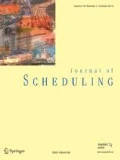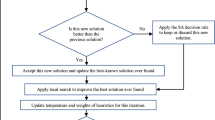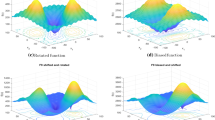Abstract
Goal separation is often a fruitful approach when solving complex problems. It provides a way to focus on relevant aspects in a stepwise fashion and hence bound the problem solving scope along a specific direction at any point. This work applies goal separation to the problem of synthesizing robust schedules. The problem is addressed by separating the phase of problem solution, which may pursue a standard optimization criterion (e.g., minimal makespan), from a subsequent phase of solution robustification in which a more flexible set of solutions is obtained and compactly represented through a temporal graph, called a Partial Order Schedule ( \(\mathcal{POS}\) ). The key advantage of a \(\mathcal{POS}\) is that it provides the capability to promptly respond to temporal changes (e.g., activity duration changes or activity start-time delays) and to hedge against further changes (e.g., new activities to perform or unexpected variations in resource capacity).
On the one hand, the paper focuses on specific heuristic algorithms for synthesis of \(\mathcal{POS}\) s, starting from a pre-existing schedule (hence the name Solve-and-Robustify). Different extensions of a technique called chaining, which progressively introduces temporal flexibility into the representation of the solution, are introduced and evaluated. These extensions follow from the fact that in multi-capacitated resource settings more than one \(\mathcal{POS}\) can be derived from a specific fixed-times solution via chaining, and carry out a search for the most robust alternative. On the other hand, an additional analysis is performed to investigate the performance gain possible by further broadening the search process to consider multiple initial seed solutions.
A detailed experimental analysis using state-of-the-art rcpsp/max benchmarks is carried out to demonstrate the performance advantage of these more sophisticated solve and robustify procedures, corroborating prior results obtained on smaller problems and also indicating how this leverage increases as problem size is increased.
Similar content being viewed by others
References
Aloulou, M. A., & Portmann, M. C. (2005). An efficient proactive-reactive scheduling approach to hedge against shop floor disturbances. In G. Kendall, E. Burke, S. Petrovic, & M. Gendreau (Eds.), Multidisciplinary scheduling: theory and applications (pp. 223–246). New York: Springer.
Artigues, C., Billaut, J. C., & Esswein, C. (2005). Maximization of solution flexibility for robust shop scheduling. European Journal of Operational Research, 165(2), 314–328.
Bartusch, M., Mohring, R. H., & Radermacher, F. J. (1988). Scheduling project networks with resource constraints and time windows. Annals of Operations Research, 16, 201–240.
Cesta, A., & Oddi, A. (2001). Algorithms for dynamic management of temporal constraints networks (Tech. rep.). ISTC-CNR, Institute for Cognitive Science and Technology, Italian National Research Council.
Cesta, A., Oddi, A., & Smith, S. F. (1998). Profile based algorithms to solve multiple capacitated metric scheduling problems. In Proceedings of the 4th international conference on artificial intelligence planning systems, AIPS-98 (pp. 214–223).
Cesta, A., Oddi, A., & Smith, S. F. (2002). A constraint-based method for project scheduling with time windows. Journal of Heuristics, 8(1), 109–136.
Chapman, D. (1987). Planning for conjuctive goals. Artificial Intelligence, 32(3), 333–377.
Cheng, C., & Smith, S. F. (1994). Generating feasible schedules under complex metric constraints. In Proceedings of the 12th national conference on artificial intelligence, AAAI-94 (pp. 1086–1091). Menlo Park: AAAI Press.
Chien, S. A., Muscettola, N., Rajan, K., Smith, B. D., & Rabideau, G. (1998). Automated planning and scheduling for goal-based autonomous spacecraft. IEEE Intelligent Systems, 13(5), 50–55.
Currie, K., & Tate, A. (1991). O-plan: The open planning architecture. Artificial Intelligence, 52(1), 49–86.
Do, M. B., & Kambhampati, S. (2003). Improving temporal flexibility of position constrained metric temporal plans. In Proceedings of the 13th international conference on automated planning & scheduling, ICAPS’03 (pp. 42–51).
Fox, M., & Long, D. (2003). PDDL2.1: An extension to PDDL for expressing temporal planning domains. Journal of Artificial Intelligence Research, 20, 61–124.
Fox, M., Gerevini, A., Long, D., & Serina, I. (2006a). Plan stability: replanning versus plan repair. In Proceedings of the 16th international conference on automated planning and scheduling, ICAPS 06 (pp. 212–221).
Fox, M., Howey, R., & Long, D. (2006b). Exploration of the robustness of plans. In Proceedings of the 21st national conference on artificial intelligence, AAAI 06 (pp. 834–839).
Godard, D., Laborie, P., & Nuitjen, W. (2005). Randomized large neighborhood search for cumulative scheduling. In Proceedings of the 15th international conference on automated planning and scheduling, ICAPS 2005 (pp. 81–89).
Kambhampati, S., Knoblock, C. A., & Yang, Q. (1995). Planning as refinement search: a unified framework for evaluating design tradeoffs in partial order planning. Artificial Intelligence, 76(1–2), 167–238.
Kolisch, R., Schwindt, C., & Sprecher, A. (1998). Benchmark instances for project scheduling problems. In J. Weglarz (Ed.), Project scheduling—recent models, algorithms and applications (pp. 197–212). Boston: Kluwer Academic.
Laborie, P., & Ghallab, M. (1995). Planning with sharable resource constraints. In Proceedings of 14th international joint conference on artificial intelligence, IJCAI-95 (pp. 1643–1651).
Laborie, P., & Godard, D. (2007). Self-adapting large neighborhood search: application to single-mode scheduling problems. In Proceedings of 3rd multidisciplinary international scheduling conference: theory and applications, MISTA-07.
Leus, R., & Herroelen, W. (2004). Stability and resource allocation in project planning. IIE Transactions, 36(7), 667–682.
Muscettola, N. (2002). Computing the envelope for stepwise-constant resource allocations. In Lecture notes in computer science: Vol. 2470. Principles and practice of constraint programming, 8th international conference, CP 2002 (pp. 139–154). Berlin: Springer.
Policella, N., Oddi, A., Smith, S. F., & Cesta, A. (2004a). Generating robust partial order schedules. In M. Wallace (Ed.), Lecture notes in computer science : Vol. 3258. Principles and practice of constraint programming, 10th international conference, CP 2004 (pp. 496–511). Berlin: Springer.
Policella, N., Smith, S. F., Cesta, A., & Oddi, A. (2004b). Generating robust schedules through temporal flexibility. In Proceedings of the 14th international conference on automated planning & scheduling, ICAPS’04 (pp. 209–218).
Policella, N., Wang, X., Smith, S. F., & Oddi, A. (2005). Exploiting temporal flexibility to obtain high quality schedules. In Proceedings of the twentieth national conference on artificial intelligence, AAAI-05 (pp. 1199–1204).
Policella, N., Cesta, A., Oddi, A., & Smith, S. F. (2007). From precedence constraint posting to partial order schedules. AI Communications, 20(3), 163–180.
Rasconi, R., Cesta, A., & Policella, N. (2008). Validating scheduling approaches against executional uncertainty. Journal of Intelligent Manufacturing (in press).
Resende, M., & Ribeiro, C. (2002). Greedy randomized adaptive search procedures. In F. Glover & G. Kochenberger (Eds.), Handbook of metaheuristics (pp. 219–249). Dordrecht: Kluwer Academic.
Smith, S. F., & Cheng, C. (1993). Slack-based heuristics for constraint satisfactions scheduling. In Proceedings of the 11th national conference on artificial intelligence, AAAI-93 (pp. 139–144). Menlo Park: AAAI Press.
Wu, S. D., Beyon, E. S., & Storer, R. H. (1999). A graph-theoretic decomposition of the job shop scheduling problem to achieve scheduling robustness. Operations Research, 47(1), 113–124.
Author information
Authors and Affiliations
Corresponding author
Rights and permissions
About this article
Cite this article
Policella, N., Cesta, A., Oddi, A. et al. Solve-and-robustify. J Sched 12, 299–314 (2009). https://doi.org/10.1007/s10951-008-0091-7
Received:
Accepted:
Published:
Issue Date:
DOI: https://doi.org/10.1007/s10951-008-0091-7




